Shoshone vs Tongan Community Comparison
COMPARE
Shoshone
Tongan
Social Comparison
Social Comparison
Shoshone
Tongans
2,256
SOCIAL INDEX
20.1/ 100
SOCIAL RATING
264th/ 347
SOCIAL RANK
7,132
SOCIAL INDEX
68.8/ 100
SOCIAL RATING
130th/ 347
SOCIAL RANK
Tongan Integration in Shoshone Communities
The statistical analysis conducted on geographies consisting of 40,378,410 people shows a moderate positive correlation between the proportion of Tongans within Shoshone communities in the United States with a correlation coefficient (R) of 0.432. On average, for every 1% (one percent) increase in Shoshone within a typical geography, there is an increase of 0.004% in Tongans. To illustrate, in a geography comprising of 100,000 individuals, a rise of 1,000 Shoshone corresponds to an increase of 4.3 Tongans.
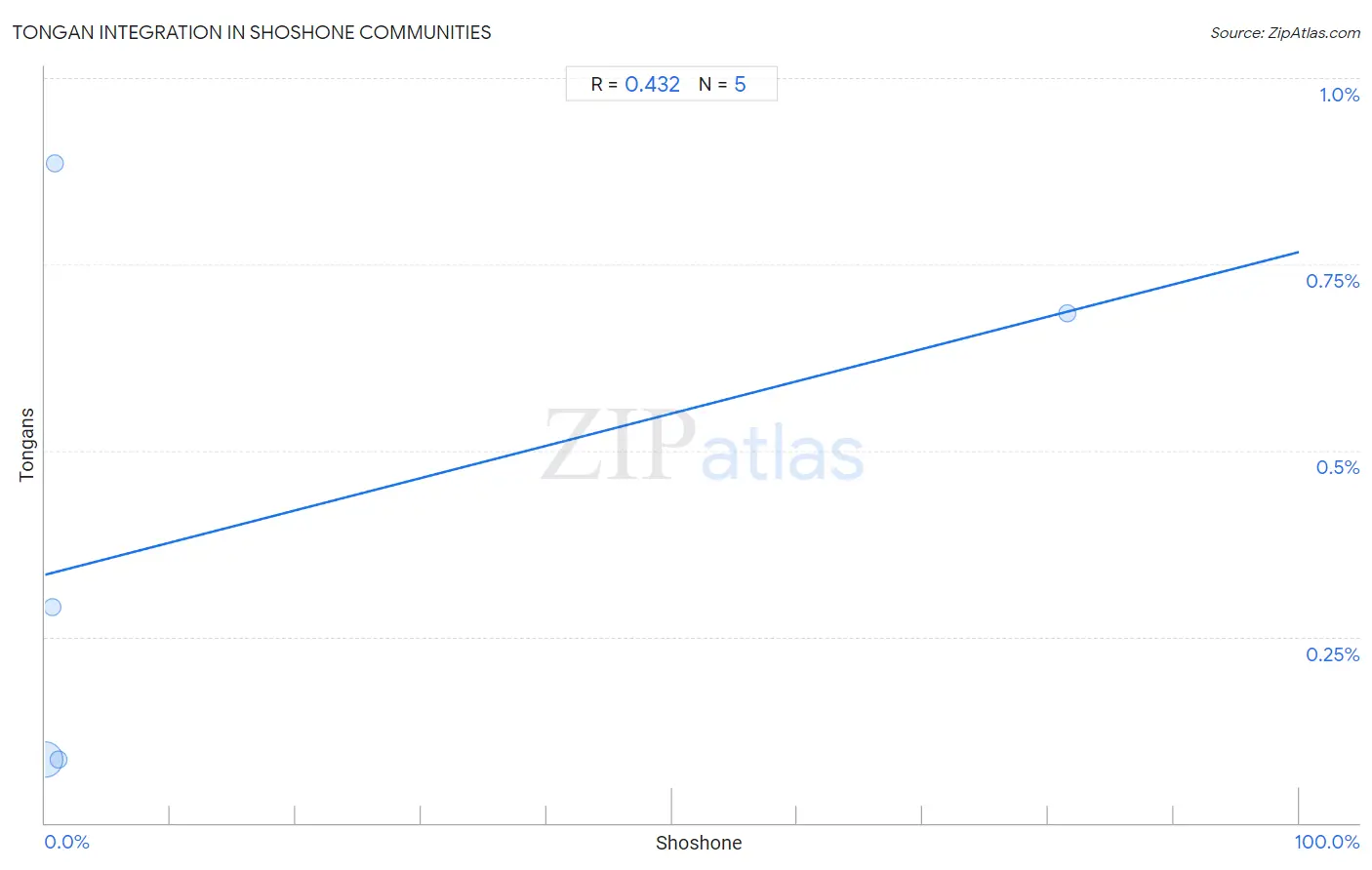
Shoshone vs Tongan Income
When considering income, the most significant differences between Shoshone and Tongan communities in the United States are seen in householder income ages 45 - 64 years ($83,588 compared to $108,643, a difference of 30.0%), median household income ($72,660 compared to $93,076, a difference of 28.1%), and householder income over 65 years ($53,681 compared to $68,235, a difference of 27.1%). Conversely, both communities are more comparable in terms of wage/income gap (25.4% compared to 27.5%, a difference of 8.0%), median female earnings ($34,677 compared to $38,288, a difference of 10.4%), and median male earnings ($47,930 compared to $53,218, a difference of 11.0%).

| Income Metric | Shoshone | Tongan |
| Per Capita Income | Tragic $37,072 | Tragic $41,693 |
| Median Family Income | Tragic $87,872 | Excellent $105,967 |
| Median Household Income | Tragic $72,660 | Exceptional $93,076 |
| Median Earnings | Tragic $40,932 | Fair $45,665 |
| Median Male Earnings | Tragic $47,930 | Fair $53,218 |
| Median Female Earnings | Tragic $34,677 | Tragic $38,288 |
| Householder Age | Under 25 years | Tragic $48,720 | Exceptional $56,972 |
| Householder Age | 25 - 44 years | Tragic $82,062 | Exceptional $99,604 |
| Householder Age | 45 - 64 years | Tragic $83,588 | Exceptional $108,643 |
| Householder Age | Over 65 years | Tragic $53,681 | Exceptional $68,235 |
| Wage/Income Gap | Good 25.4% | Tragic 27.5% |
Shoshone vs Tongan Poverty
When considering poverty, the most significant differences between Shoshone and Tongan communities in the United States are seen in single father poverty (22.9% compared to 12.2%, a difference of 87.6%), single male poverty (16.7% compared to 10.5%, a difference of 59.5%), and child poverty among boys under 16 (19.4% compared to 13.4%, a difference of 45.2%). Conversely, both communities are more comparable in terms of single mother poverty (32.9% compared to 26.5%, a difference of 24.0%), seniors poverty over the age of 75 (13.1% compared to 10.5%, a difference of 24.8%), and receiving food stamps (12.4% compared to 9.7%, a difference of 27.7%).
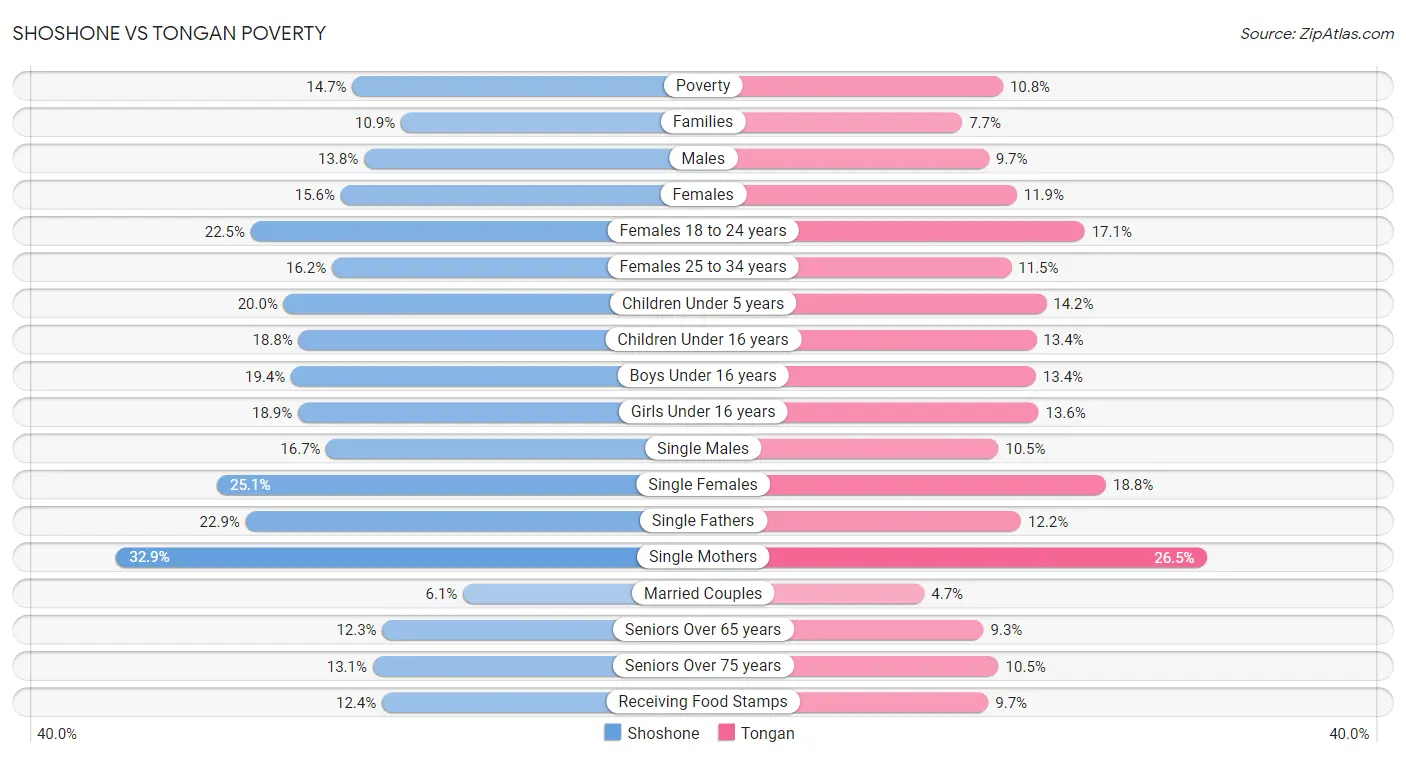
| Poverty Metric | Shoshone | Tongan |
| Poverty | Tragic 14.7% | Exceptional 10.8% |
| Families | Tragic 10.9% | Exceptional 7.7% |
| Males | Tragic 13.8% | Exceptional 9.7% |
| Females | Tragic 15.6% | Exceptional 11.9% |
| Females 18 to 24 years | Tragic 22.5% | Exceptional 17.1% |
| Females 25 to 34 years | Tragic 16.2% | Exceptional 11.5% |
| Children Under 5 years | Tragic 20.0% | Exceptional 14.2% |
| Children Under 16 years | Tragic 18.8% | Exceptional 13.4% |
| Boys Under 16 years | Tragic 19.4% | Exceptional 13.4% |
| Girls Under 16 years | Tragic 18.9% | Exceptional 13.6% |
| Single Males | Tragic 16.7% | Exceptional 10.5% |
| Single Females | Tragic 25.1% | Exceptional 18.8% |
| Single Fathers | Tragic 22.9% | Exceptional 12.2% |
| Single Mothers | Tragic 32.9% | Exceptional 26.5% |
| Married Couples | Tragic 6.1% | Exceptional 4.7% |
| Seniors Over 65 years | Tragic 12.3% | Exceptional 9.3% |
| Seniors Over 75 years | Tragic 13.1% | Exceptional 10.5% |
| Receiving Food Stamps | Poor 12.4% | Exceptional 9.7% |
Shoshone vs Tongan Unemployment
When considering unemployment, the most significant differences between Shoshone and Tongan communities in the United States are seen in unemployment among women with children under 6 years (13.2% compared to 6.9%, a difference of 90.6%), unemployment among ages 55 to 59 years (7.4% compared to 4.3%, a difference of 72.2%), and unemployment among ages 25 to 29 years (9.2% compared to 5.5%, a difference of 67.3%). Conversely, both communities are more comparable in terms of unemployment among seniors over 75 years (8.6% compared to 10.4%, a difference of 20.4%), unemployment among ages 16 to 19 years (19.3% compared to 15.9%, a difference of 21.3%), and unemployment among ages 60 to 64 years (5.7% compared to 4.6%, a difference of 22.1%).
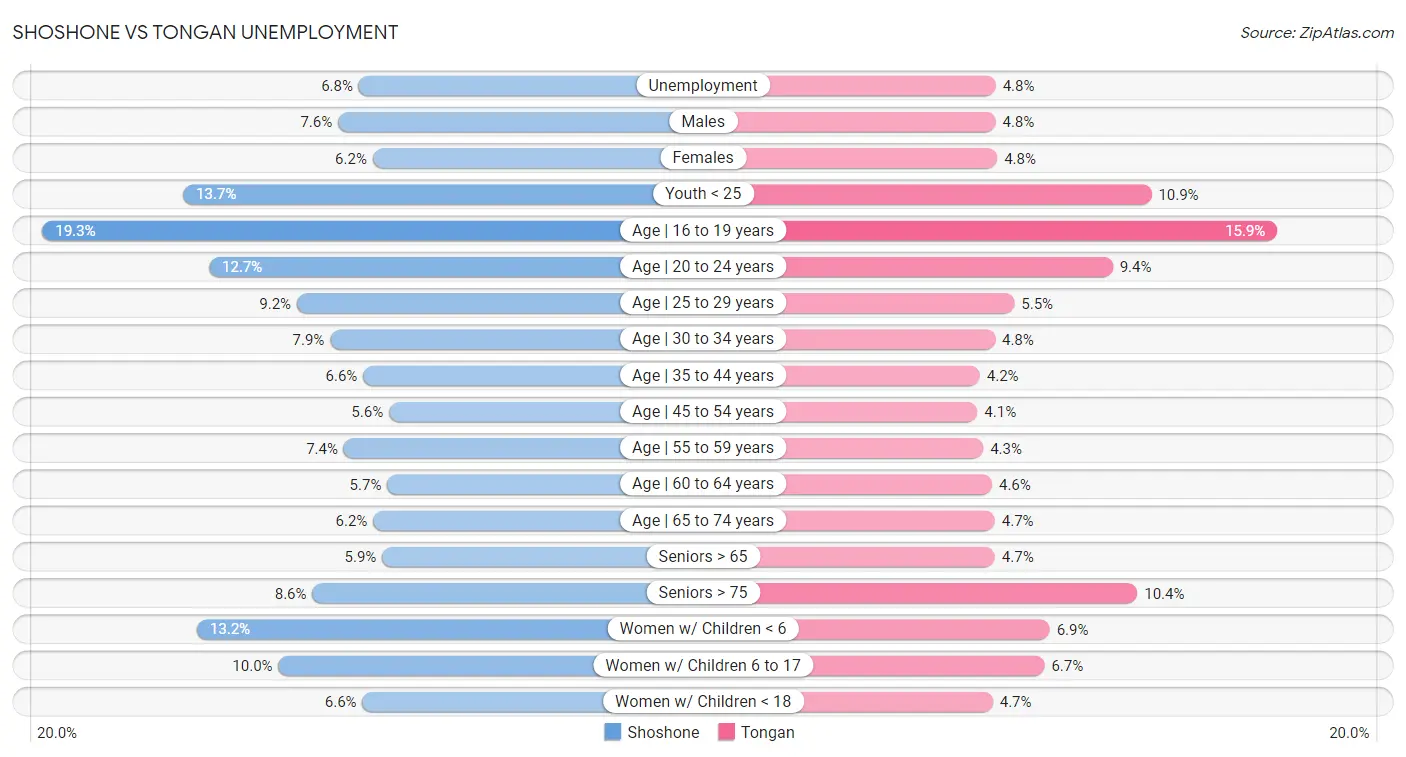
| Unemployment Metric | Shoshone | Tongan |
| Unemployment | Tragic 6.8% | Exceptional 4.8% |
| Males | Tragic 7.6% | Exceptional 4.8% |
| Females | Tragic 6.2% | Exceptional 4.8% |
| Youth < 25 | Tragic 13.7% | Exceptional 10.9% |
| Age | 16 to 19 years | Tragic 19.3% | Exceptional 15.9% |
| Age | 20 to 24 years | Tragic 12.7% | Exceptional 9.4% |
| Age | 25 to 29 years | Tragic 9.2% | Exceptional 5.5% |
| Age | 30 to 34 years | Tragic 7.9% | Exceptional 4.8% |
| Age | 35 to 44 years | Tragic 6.6% | Exceptional 4.2% |
| Age | 45 to 54 years | Tragic 5.6% | Exceptional 4.1% |
| Age | 55 to 59 years | Tragic 7.4% | Exceptional 4.3% |
| Age | 60 to 64 years | Tragic 5.7% | Exceptional 4.6% |
| Age | 65 to 74 years | Tragic 6.2% | Exceptional 4.7% |
| Seniors > 65 | Tragic 5.9% | Exceptional 4.7% |
| Seniors > 75 | Good 8.6% | Tragic 10.4% |
| Women w/ Children < 6 | Tragic 13.2% | Exceptional 6.9% |
| Women w/ Children 6 to 17 | Tragic 10.0% | Exceptional 6.7% |
| Women w/ Children < 18 | Tragic 6.6% | Exceptional 4.7% |
Shoshone vs Tongan Labor Participation
When considering labor participation, the most significant differences between Shoshone and Tongan communities in the United States are seen in in labor force | age > 16 (63.2% compared to 67.5%, a difference of 6.8%), in labor force | age 45-54 (79.3% compared to 83.1%, a difference of 4.9%), and in labor force | age 16-19 (39.3% compared to 41.2%, a difference of 4.8%). Conversely, both communities are more comparable in terms of in labor force | age 35-44 (82.2% compared to 83.6%, a difference of 1.8%), in labor force | age 20-24 (76.1% compared to 77.9%, a difference of 2.4%), and in labor force | age 30-34 (81.4% compared to 83.5%, a difference of 2.5%).

| Labor Participation Metric | Shoshone | Tongan |
| In Labor Force | Age > 16 | Tragic 63.2% | Exceptional 67.5% |
| In Labor Force | Age 20-64 | Tragic 76.8% | Exceptional 80.3% |
| In Labor Force | Age 16-19 | Exceptional 39.3% | Exceptional 41.2% |
| In Labor Force | Age 20-24 | Exceptional 76.1% | Exceptional 77.9% |
| In Labor Force | Age 25-29 | Tragic 81.6% | Average 84.7% |
| In Labor Force | Age 30-34 | Tragic 81.4% | Tragic 83.5% |
| In Labor Force | Age 35-44 | Tragic 82.2% | Tragic 83.6% |
| In Labor Force | Age 45-54 | Tragic 79.3% | Excellent 83.1% |
Shoshone vs Tongan Family Structure
When considering family structure, the most significant differences between Shoshone and Tongan communities in the United States are seen in divorced or separated (14.0% compared to 11.1%, a difference of 26.8%), births to unmarried women (35.3% compared to 28.4%, a difference of 24.4%), and family households with children (26.5% compared to 31.2%, a difference of 17.8%). Conversely, both communities are more comparable in terms of average family size (3.37 compared to 3.49, a difference of 3.5%), single father households (2.6% compared to 2.5%, a difference of 4.1%), and family households (63.8% compared to 69.6%, a difference of 9.1%).

| Family Structure Metric | Shoshone | Tongan |
| Family Households | Tragic 63.8% | Exceptional 69.6% |
| Family Households with Children | Tragic 26.5% | Exceptional 31.2% |
| Married-couple Households | Tragic 43.9% | Exceptional 51.6% |
| Average Family Size | Exceptional 3.37 | Exceptional 3.49 |
| Single Father Households | Tragic 2.6% | Tragic 2.5% |
| Single Mother Households | Tragic 6.8% | Exceptional 5.8% |
| Currently Married | Tragic 44.0% | Exceptional 48.3% |
| Divorced or Separated | Tragic 14.0% | Exceptional 11.1% |
| Births to Unmarried Women | Tragic 35.3% | Exceptional 28.4% |
Shoshone vs Tongan Vehicle Availability
When considering vehicle availability, the most significant differences between Shoshone and Tongan communities in the United States are seen in no vehicles in household (10.8% compared to 7.2%, a difference of 50.7%), 4 or more vehicles in household (8.8% compared to 10.0%, a difference of 13.5%), and 2 or more vehicles in household (57.9% compared to 63.5%, a difference of 9.8%). Conversely, both communities are more comparable in terms of 1 or more vehicles in household (89.5% compared to 92.9%, a difference of 3.7%), 3 or more vehicles in household (24.9% compared to 26.5%, a difference of 6.6%), and 2 or more vehicles in household (57.9% compared to 63.5%, a difference of 9.8%).

| Vehicle Availability Metric | Shoshone | Tongan |
| No Vehicles Available | Fair 10.8% | Exceptional 7.2% |
| 1+ Vehicles Available | Fair 89.5% | Exceptional 92.9% |
| 2+ Vehicles Available | Exceptional 57.9% | Exceptional 63.5% |
| 3+ Vehicles Available | Exceptional 24.9% | Exceptional 26.5% |
| 4+ Vehicles Available | Exceptional 8.8% | Exceptional 10.0% |
Shoshone vs Tongan Education Level
When considering education level, the most significant differences between Shoshone and Tongan communities in the United States are seen in doctorate degree (1.4% compared to 1.7%, a difference of 24.5%), bachelor's degree (29.3% compared to 34.3%, a difference of 17.1%), and no schooling completed (2.0% compared to 2.3%, a difference of 13.4%). Conversely, both communities are more comparable in terms of high school diploma (88.3% compared to 88.4%, a difference of 0.13%), 12th grade, no diploma (90.5% compared to 90.7%, a difference of 0.27%), and 11th grade (92.5% compared to 92.2%, a difference of 0.33%).
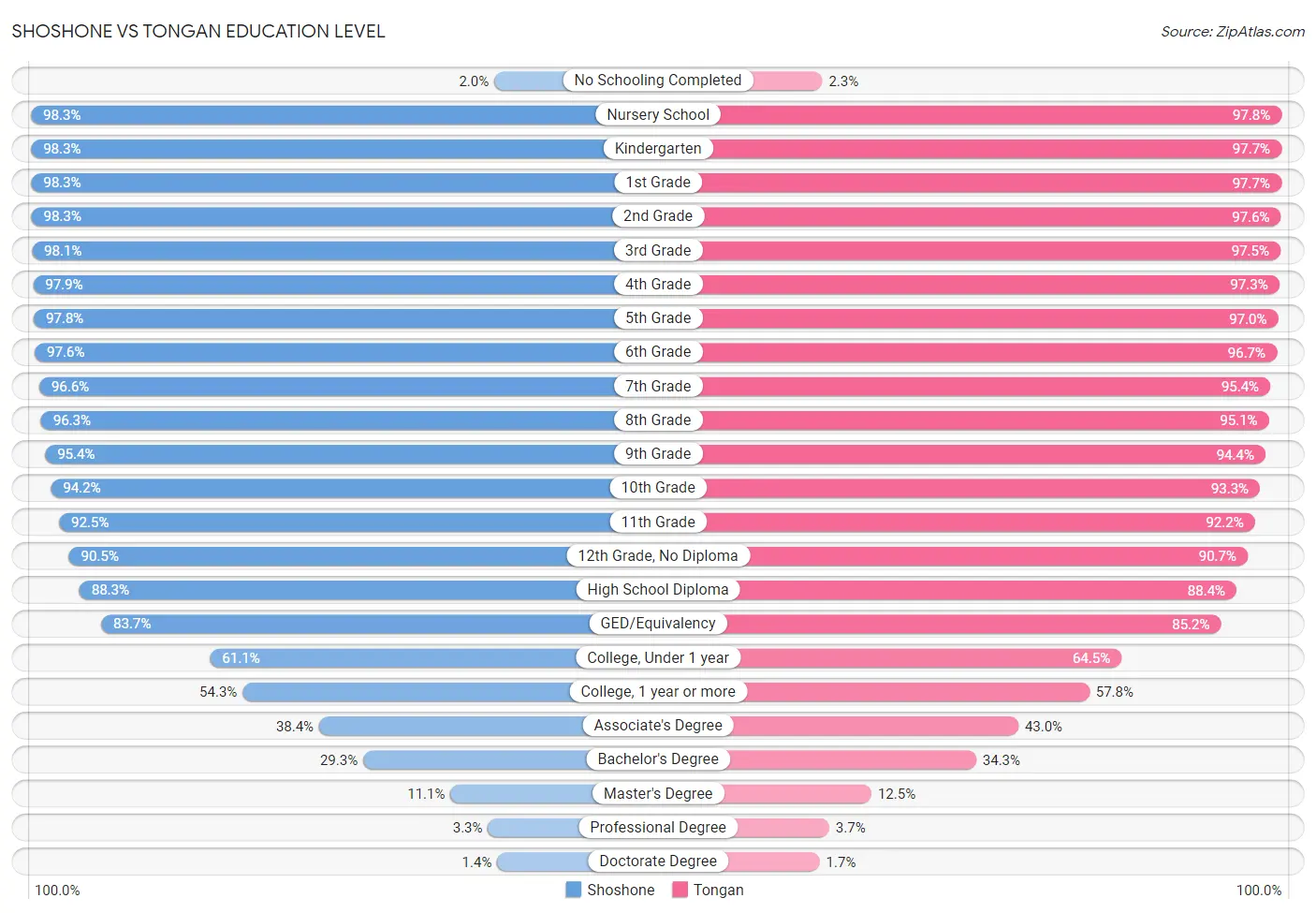
| Education Level Metric | Shoshone | Tongan |
| No Schooling Completed | Good 2.0% | Tragic 2.3% |
| Nursery School | Exceptional 98.3% | Tragic 97.8% |
| Kindergarten | Exceptional 98.3% | Tragic 97.7% |
| 1st Grade | Exceptional 98.3% | Tragic 97.7% |
| 2nd Grade | Exceptional 98.3% | Tragic 97.6% |
| 3rd Grade | Exceptional 98.1% | Tragic 97.5% |
| 4th Grade | Exceptional 97.9% | Tragic 97.3% |
| 5th Grade | Exceptional 97.8% | Tragic 97.0% |
| 6th Grade | Exceptional 97.6% | Tragic 96.7% |
| 7th Grade | Exceptional 96.6% | Tragic 95.4% |
| 8th Grade | Exceptional 96.3% | Tragic 95.1% |
| 9th Grade | Exceptional 95.4% | Tragic 94.4% |
| 10th Grade | Exceptional 94.2% | Tragic 93.3% |
| 11th Grade | Average 92.5% | Poor 92.2% |
| 12th Grade, No Diploma | Tragic 90.5% | Poor 90.7% |
| High School Diploma | Tragic 88.3% | Tragic 88.4% |
| GED/Equivalency | Tragic 83.7% | Fair 85.2% |
| College, Under 1 year | Tragic 61.1% | Fair 64.5% |
| College, 1 year or more | Tragic 54.3% | Poor 57.8% |
| Associate's Degree | Tragic 38.4% | Tragic 43.0% |
| Bachelor's Degree | Tragic 29.3% | Tragic 34.3% |
| Master's Degree | Tragic 11.1% | Tragic 12.5% |
| Professional Degree | Tragic 3.3% | Tragic 3.7% |
| Doctorate Degree | Tragic 1.4% | Poor 1.7% |
Shoshone vs Tongan Disability
When considering disability, the most significant differences between Shoshone and Tongan communities in the United States are seen in hearing disability (4.0% compared to 2.9%, a difference of 38.7%), disability age 35 to 64 (14.5% compared to 10.5%, a difference of 37.6%), and vision disability (2.7% compared to 2.0%, a difference of 35.6%). Conversely, both communities are more comparable in terms of cognitive disability (17.3% compared to 17.8%, a difference of 2.7%), disability age over 75 (49.9% compared to 48.3%, a difference of 3.1%), and disability age 5 to 17 (5.6% compared to 5.0%, a difference of 11.1%).
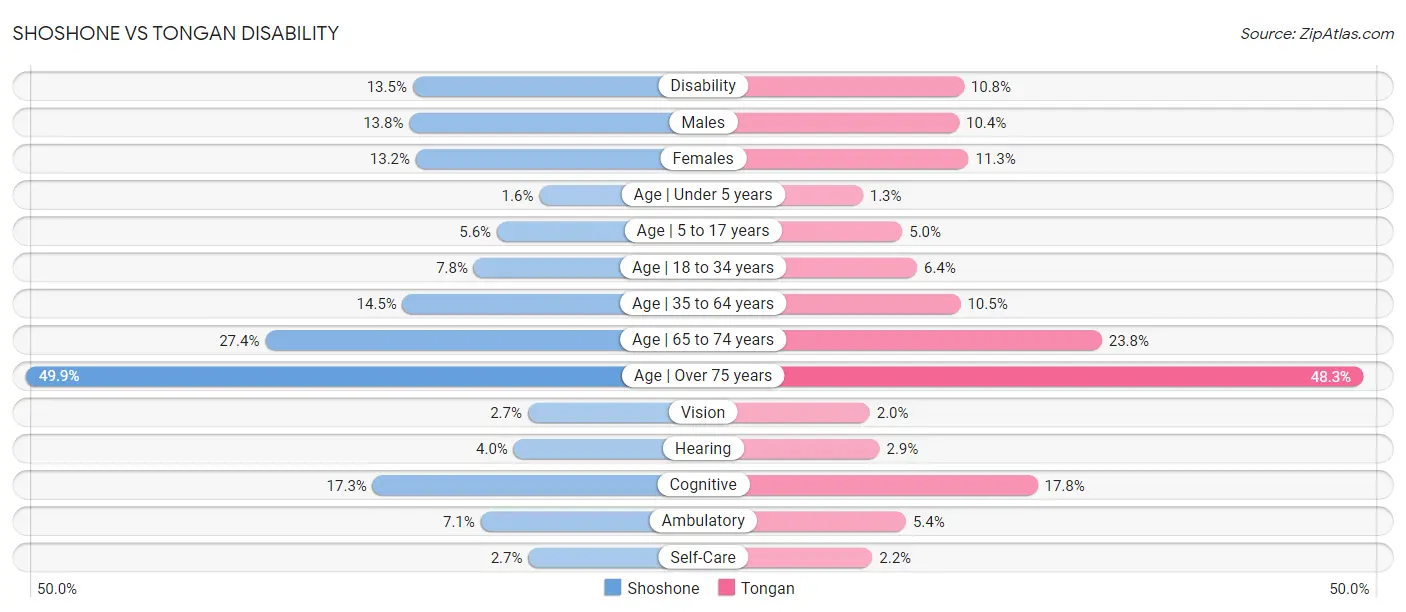
| Disability Metric | Shoshone | Tongan |
| Disability | Tragic 13.5% | Exceptional 10.8% |
| Males | Tragic 13.8% | Exceptional 10.4% |
| Females | Tragic 13.2% | Exceptional 11.3% |
| Age | Under 5 years | Tragic 1.6% | Tragic 1.3% |
| Age | 5 to 17 years | Average 5.6% | Exceptional 5.0% |
| Age | 18 to 34 years | Tragic 7.8% | Excellent 6.4% |
| Age | 35 to 64 years | Tragic 14.5% | Exceptional 10.5% |
| Age | 65 to 74 years | Tragic 27.4% | Fair 23.8% |
| Age | Over 75 years | Tragic 49.9% | Tragic 48.3% |
| Vision | Tragic 2.7% | Exceptional 2.0% |
| Hearing | Tragic 4.0% | Good 2.9% |
| Cognitive | Average 17.3% | Tragic 17.8% |
| Ambulatory | Tragic 7.1% | Exceptional 5.4% |
| Self-Care | Tragic 2.7% | Exceptional 2.2% |